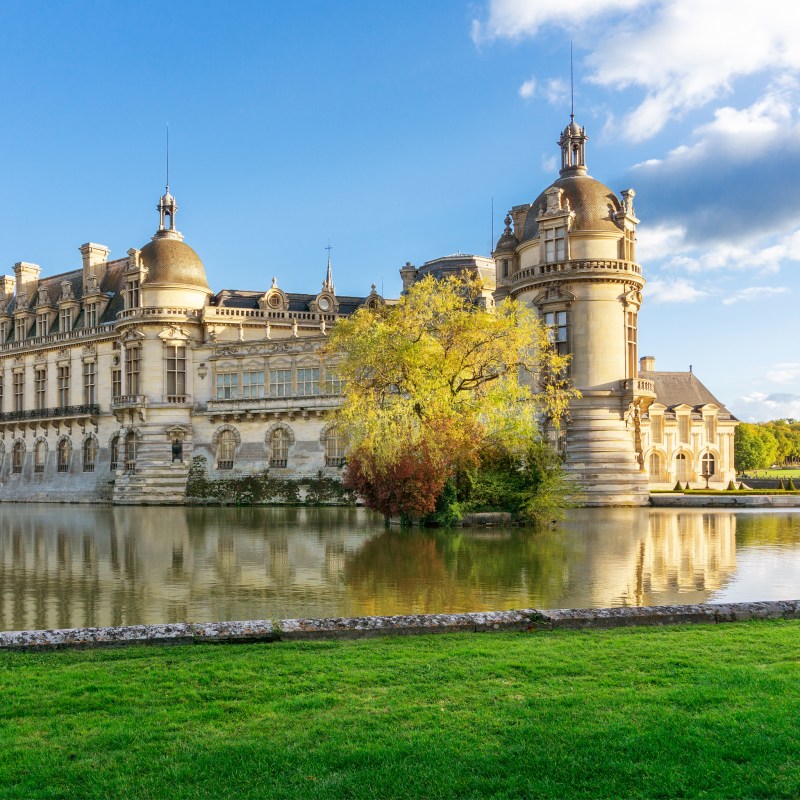
Have you seen the James Bond film A View to a Kill? The scenes at the villain’s fabulous country estate were filmed at the Chateau de Chantilly, and the chateau’s stables and racecourse also made an appearance. In real life, the structure belonged to Henri d’Orleans, Duke of Aumale, the son of the last king of France. The duke’s castle outside of Paris wasn’t the only impressive thing he owned — he also amassed a priceless collection of art and books. The result is that the chateau, its grounds, and everything else the small town has to offer are well worth exploring on a day trip from Paris.
Videos by TravelAwaits
A mere 34 miles from Paris, this amazing place can be reached by train in less than 30 minutes. From Paris’s Gare du Nord, simply take the train to Gare Chantilly-Gouvieux. The trains run every hour, and it’s just a lovely 15-minute walk from the station to the chateau.
Once you are there, you will be able to enjoy an utterly royal day out. Here are my favorite things to see and do in Chantilly.
Explore The Market
If you arrive in town on a Wednesday or Saturday morning, make sure to check out the fresh produce at the weekly market on Place Omer Vallon. You will walk by it coming from the train station and heading toward the chateau at the other end of Chantilly.
After you’ve explored the market, you can choose from two scenic routes from the market to the chateau: along the main street, Rue du Connetable, with its small shops, or along Rue d’Aumale, where the guards used to live, right next to the racecourse. Both lead to the castle.

See The Chateau And Its Art
Henri d’Orleans was a serious collector. His chateau consists of an older part, built in 1358, and a newer part, dating to the 1800s, which has been turned into a museum. The museum holds his art collection, which is second only to the collection at the Louvre in size. Much of the artwork depicts scenes of war, since the duke was a military man, but there is much more to discover. Be sure to search out the small mosaics on two pedestals — they are true masterpieces, and my personal favorites. The rooms are magnificent and only enhanced by the art, but do peek out of the windows as well — the views haven’t changed much over hundreds of years.

Marvel At The Books In The Library
My favorite part of the chateau, however, is the library; it’s simply perfect, with its floor-to-ceiling books, mezzanine level accessed by a wooden staircase, and reading nooks. Make sure to take time to examine the books in the vitrines in the center of the room; they are very old — many of them handwritten and illustrated — and just stunning. Hats off to Henri d’Orleans for gathering so many beautiful examples for this amazing collection!

Saunter Through The Le Notre Gardens
The gardens of the Chateau de Chantilly are actually three gardens stretching across more than 280 acres. The oldest is the French Garden, created by none other than master gardener Andre Le Notre of Versailles and Tuileries fame. Stylized, ornate, and organized, it is a garden where you can easily visualize royalty strolling about. In the 18th century, the Anglo-Chinese Garden was added, complete with half-timbered cottages in a village setting, and, in the 19th century, the English Garden, complete with love temples, ornate pavilions, and small canals, was constructed. Even if you are not a garden enthusiast, you could easily spend hours here, strolling and exploring.

Stop At The Museum Of The Horse
Located in the Great Stables, The Museum of the Horse features stalls with actual horses in them. This is very obviously not just a museum, but a working stable. You’ll learn everything you ever wanted to know about horses throughout history, see some 200 horse-related historical objects, and stand in the court and watch riders train their horses. If you are lucky, you might even be there in time for an event — the stables regularly put on shows and equestrian demonstrations.

Learn About Engineering At The Pavillon De Manse
An engineering marvel that provided water to the chateau’s gardens and later drinking water to the chateau, the Pavillon de Manse houses a smaller-scale version of the Machine de Marly that provided Versailles’s fountains with water. Built in 1678 and named after hydraulic engineer Jacques de Manse, the site is now a museum where you can learn about this 17th-century feat of engineering.
Appreciate Chantilly’s Famous Lace
Chantilly lace is world famous, and the art itself is utterly amazing. The intricate knotting and twisting of thin silk strands with dozens of wooden bobbins by hand is, sadly, a dying art. But in the 17th century, it was popular with the rich, who were the only ones who could afford the adornments that took hours and days to complete. Chantilly’s small museum dedicated to the art has some lovely examples of Chantilly lace, from shawls to lace collars to entire dresses.
Take The Grandkids To The Potager Des Princes
Despite its name, the Potager des Princes was never a prince’s vegetable plot; it was a fancy park designed by Le Notre for the many pheasants owned by residents of the chateau. It was later sold and privately owned, and not long ago it was rescued from destruction and made into the park it is today. It’s a quirky place full of animals, from chicken to rabbits — and yes, there are still plenty of pheasants. You’ll find Japanese gardens and a bamboo maze, canals, statues, and interesting historic landscaping. It is a fun place to explore if you have time to spare, but it’s a must if you are traveling with your grandchildren.
Check Out The Racecourse
Chantilly and its forest have been associated with horses for centuries, due to the good hunting that was to be had around the chateau. But in the 1800s, horse racing became even more popular than hunting. The Chantilly racecourse is France’s oldest and has one of the country’s oldest and largest training centers, with up to 2,000 horses in training at any given time. Two of France’s most important races — the Prix du Jockey Club, also known as the French Derby, and the Prix de Diane, or the French Oaks — take place in Chantilly against the magnificent backdrop of the Great Stables and the chateau. But whether you catch a race or not, just walking alongside the track is worthwhile, since you’ll likely see horses training.
Indulge At The Auberge Du Jeu De Paume
The Auberge du Jeu de Paume, a luxury hotel and spa, is the perfect place near the chateau to spend the night. But if you are just in Chantilly for the day, make this a stop for some indulgences: There is a two-star Michelin restaurant in-house, a chic winter garden brasserie, a cozy bar, and an afternoon tea at which you can sample Chantilly’s famously sweet whipped cream. If Michelin stars are out of your reach, the set lunch menu is very affordable, and the bar offers a delicious Jockey Sandwich with salmon, cucumber, and cream cheese to accompany your glass of champagne.
Stroll Through The Forest
The 15,675-acre Chantilly Forest is the reason why the chateau was built here in the first place. In the shade of the oak trees, limes, hornbeams, and pines, you’ll find plenty of hiking and walking trails, none of them strenuous. It is a perfect green oasis — so different from the manicured gardens of the chateau, and yet just across the road.
Just be aware that hunting is still a popular sport in France, from boar hunting in early summer to deer hunting after September. But there will be plenty of signage at the entrance points to the forest warning you, and the sections open to hikers are generally not used by hunters.
What To Know Before You Go
Make sure that you wear good, comfortable shoes for walking. Chantilly might be a small place, but you will rack up the steps walking between the station and the chateau, exploring the gardens, walking up and down the racecourse, visiting the castle, and hiking through the forest. It’s nothing strenuous, since it’s all very level, but there is still a fair amount of walking involved.
